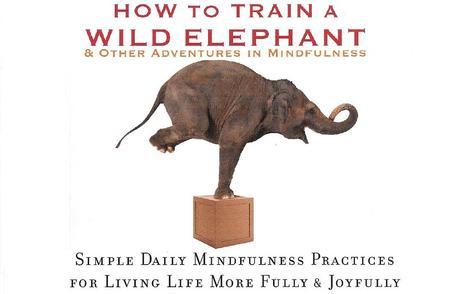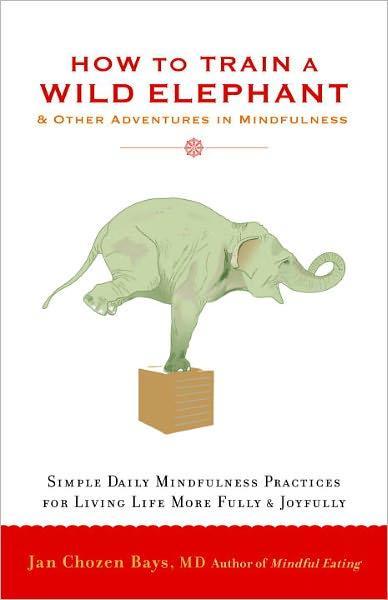
You hardly need me to tell you that busy lifestyles and increasing stress levels can only endure up to a limit. Soon enough, we reach that point when we become desperate to find ways to bring back that balance in life, and yearn to slow down. Here's where mindfulness comes in, as a solution for those that aim to lead a meaningful life. Of course there's research for the skeptic, proving that mindfulness brings significant benefits-both for mental and physical health.
Not the first time I am saying this, but mindfulness is the act of consciously paying attention to everything happening around us and within us, without criticism, without judgment. It is about not living on autopilot.
I have a book review for you today.
How to Train a Wild Elephant & Other Adventures in Mindfulness: Simple Daily Mindfulness Practices For living life more fully and joyfully By Jan Chozen Bays, M.D. Author of Mindful Eating, Published by Shambala Publications, Inc., 224 Pages | ISBN 978-1-59030-817-2
 Book blurb A growing body of research is showing that mindfulness can reduce stress, improve physical health, and improve one's overall quality of life. Jan Chozen Bays, MD-physician and Zen teacher-has developed a series of simple practices to help us cultivate mindfulness as we go about our ordinary, daily lives. Exercises include: taking three deep breaths before answering the phone, noticing and adjusting your posture throughout the day, eating mindfully, and leaving no trace of yourself after using the kitchen or bathroom. Each exercise is presented with tips on how to remind yourself and a short life lesson connected with it. My book review
Book blurb A growing body of research is showing that mindfulness can reduce stress, improve physical health, and improve one's overall quality of life. Jan Chozen Bays, MD-physician and Zen teacher-has developed a series of simple practices to help us cultivate mindfulness as we go about our ordinary, daily lives. Exercises include: taking three deep breaths before answering the phone, noticing and adjusting your posture throughout the day, eating mindfully, and leaving no trace of yourself after using the kitchen or bathroom. Each exercise is presented with tips on how to remind yourself and a short life lesson connected with it. My book review Why the title "How to train a wild elephant?" According to the Buddha, taming the mind is like taming a wild forest elephant. You know what havoc a wild elephant can create; in the same way, the untamed mind can harm us and those around us. We know that our mental capacity is far more than we realize, and mindfulness is a potent tool to train the mind, helping us realize the true potential for insight, kindness and creativity. Once we tame our minds, we become calm and stable as we face tough times in life. Rather than run away from problems, we see them as a way to test and strengthen our physical and mental stability.
It is easy enough to start practicing mindfulness; all it takes is for us to focus on one small area in our life until it becomes a habit. Gradually, as we add more mindfulness practices, we become present and aware of each moment, and open up to an awakened life.
In her beautifully presented book "How to train a wild elephant" Jan Chozen Bays, who is also a longtime meditation teacher and physician, shares a series of exercises that specifically outline how to cultivate mindfulness. They address various aspects of our lives and are geared to help the reader become aware, happy, and comfortable with her busy life.
I particularly enjoyed the layout of the book.
Each chapter offers one exercise and is divided into several sections beginning with a description of the task, and ideas to help you remind yourself to do it throughout the day and week. This is followed by "Discoveries" listing peoples' insight and feedback and "Deeper lessons" which explores the themes and life lessons related to the exercise. The chapter concludes with "Final Words", a summary of the exercise.
The 53 exercises in the book are fun and easy. For example,
- Use your non-dominant hand to perform routine tasks each day.
- Choose one room in your house. For one week, leave no trace that you used that space.
- Eliminate filler words from your speech, that is, words that add no meaning to what you say.
- Once a day think of someone close to you and give them a genuine compliment.
A great suggestion offered in the book is buddying up with others to take action on the 53 interesting exercises described as individual chapters.
The point is, mindfulness is not something one must squeeze into an already full schedule. Rather, incorporating mindfulness into our lives is a game of connecting the dots. Quite like those paint by numbers kits where each section is numbered to tell you which matching color to use. As you follow the color codes and color the picture, a pleasing visual emerges. Doesn't that sound nice?
The best part is, you don't need to seek expensive retreats or invest in expensive gadgets to practice mindfulness. You already have what you need. What you do need to do is make a shift in your perspective.
The whole point of the book is to become mindfully aware and be present in each moment so we can appreciate and be grateful and be happy. The author specifically lists the benefits of mindfulness while busting some interesting myths about being mindful.
You must have figured out by now why the book has 52 exercises-the idea is to make mindfulness a habit by using one exercise per week for 52 weeks of the year.
The author also suggests journaling your experiences to record and review your experience, and I think that's a great idea. I've tried, and made it a practice.
Some of the exercises in this book can be extended into periods of meditation, contemplation, or prayer.
The "Deeper lessons" part of each chapter is invaluable, giving us an insight into the benefits we can enjoy by practicing the exercise.
The message of the book, mainly, is this: not being present leads to dissatisfaction and unhappiness, while being in the present moment is restful and enjoyable, bringing a sense of discovery to even the most mundane of everyday activities. Being mindful is clearly the best way to improve our overall quality of life.
Let me share one of the exercises in the book:
Parents, try this on your kids. Make it a game. It'll be fun. And who knows, a welcome habit may be formed.
Leave No Trace How to do it:Pick a room in your house. For one week, try leaving no trace that you've used that space. I tried with the bathroom and kitchen, since these are busy areas and could do with the clear up. If you picked the bathroom, after you use it, clean it in such a way that there are no signs of your having been there. Kitchen? Clear up everything except the aroma of the cooking.
How to remind yourselfPut up a sign "Leave no trace" in the room you picked.
Did you know that in Zen paintings turtles symbolize this practice of leaving no traces, because they sweep the sand with their tails as they creep along, wiping out their footprints? You can also use small pictures of turtles instead of a written reminder
DiscoveriesThe usual tendency is to leave rooms a bit messier than when we entered. We think, "I'll clean it up later." Later never comes, until the mess is unbearable, and it is a chore to do it. And yes, we also get mad at someone else for not doing their share of the housework. What if we take care of things right away and eliminate the annoyance that comes with accumulating the mess? Think of all the things that you could, but postpone. Practising leaving no trace may actually help you grow the habit of extending it to all other areas. Initially tough, but easier as you go along.
Deeper lessonThis exercise makes us aware of our penchant to be lazy. No, no, not as criticism, but a description. When we live less wholeheartedly, we leave messes. Also, so much easier to be lazy. What if we became aware of all the little things that support our life and work all day-spoons forks that feed us, clothes that keep us warm, rooms that shelter us? When we wash, dry, fold, clean...we express gratitude to these things.
Practising "leaving no traces" leads to practising leaving things better than you found them. Ideally, the only traces we will leave will be the ways we have loved, inspired, taught, or served others. This is what will have the most positive effect on people in the future.
The book carries a subtle sense of humor in parts, for example, this "Final words" at the end of one of the exercises made me laugh:
"I think you're all enlightened until you open your mouths."-Zen master Suzuki Roshi
Little gems such as "The two hands work together effortlessly to accomplish many wonderful things and they never harm each other. Could this become true for any two human beings? " brought home wonderful life lessons.
I'd share another interesting exercise, but I am going to save that up for another alphabet/post.
How to Train a Wild Elephant & Other Adventures in Mindfulness , Simple Daily Mindfulness Practices For living life more fully and joyfully By Jan Chozen Bays, M.D. is a brilliant and practical book, easy to read, and easy to keep returning to, any time. I loved it, and so might you.
You can buy the book on Amazon, if you like.
How do you practice mindfulness?

Writer, editor, blogger, social media enthusiast. Love DIY, Coffee, Music, Reading, Photography, Family, Friends and Life. Mantra: Happiness is a DIY Project. In my free time I play with my dust bunnies and show my diabetes who's boss. Tweet as @vidyasury

